Abstract
1. 2-Deoxy-2-fluoro-d-glucose, 2-deoxy-2-fluoro-d-mannose and 2-deoxy-2,2-difluoro-d-arabino-hexose are good substrates for yeast hexokinase. 2. 3-Deoxy-3-fluoro-d-glucose and 4-deoxy-4-fluoro-d-glucose are poor substrates and have very similar Km values (8×10−2m). 3. Neither α- nor β-d-glucopyranosyl fluoride is a substrate or inhibitor. 4. Studies with 2-chloro-2-deoxy- and 2-O-methyl derivatives of d-glucose and d-mannose have revealed that little chemical modification is possible at position 2 without substantial loss in substrate binding. 5. The variation in the value of Km for the d-hexose derivatives was associated with a corresponding change in the value of Km for MgATP2− showing that the binding of MgATP2− is modified by the binding of the sugar.
Full text
PDF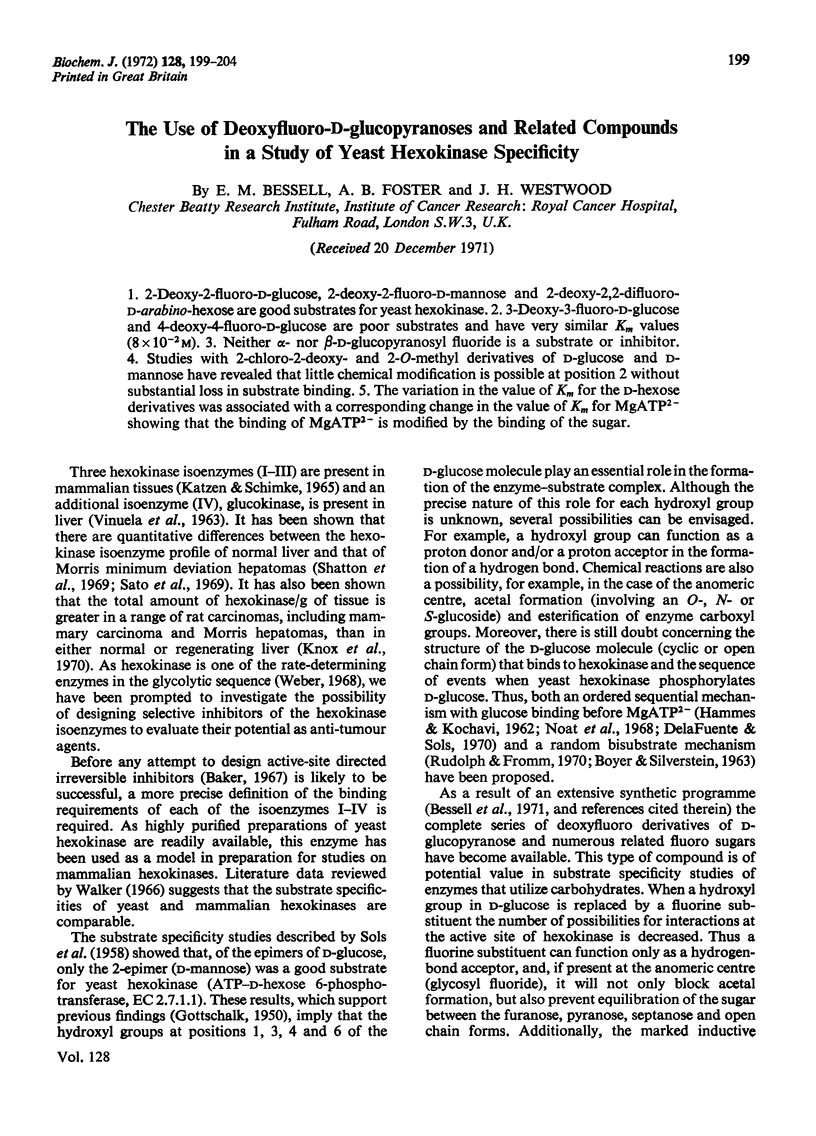
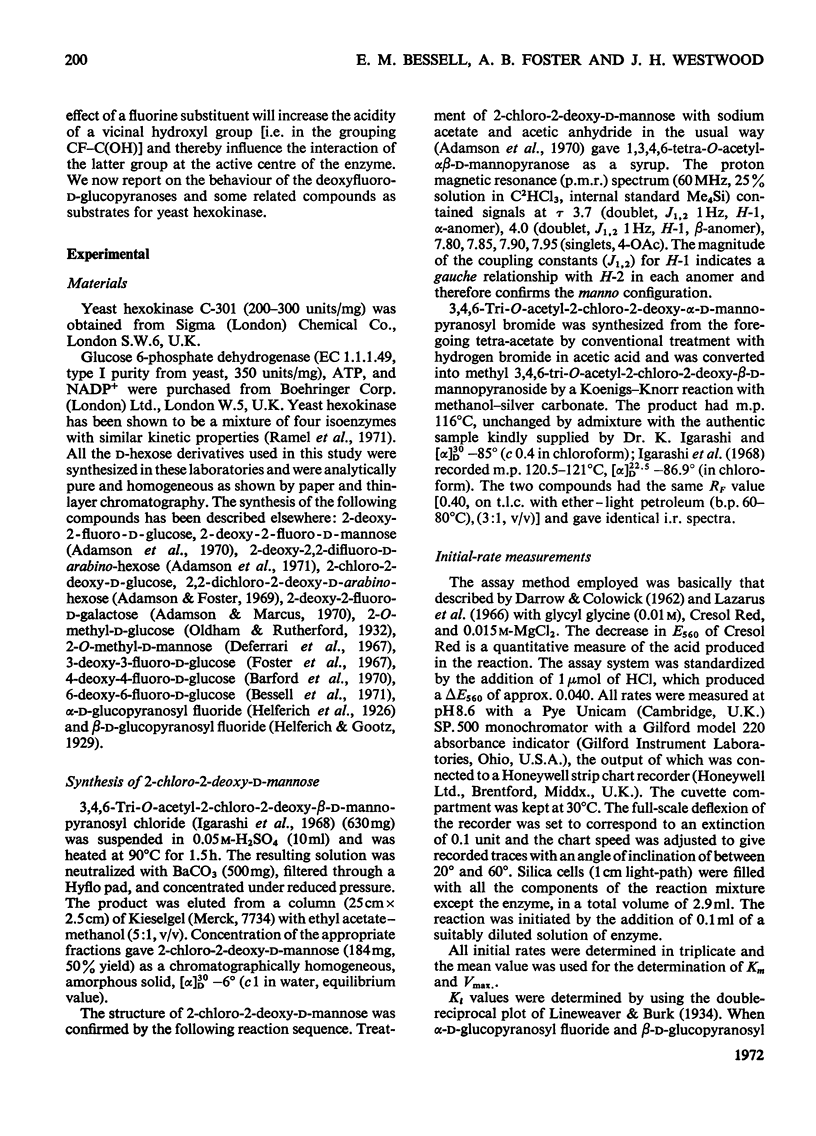
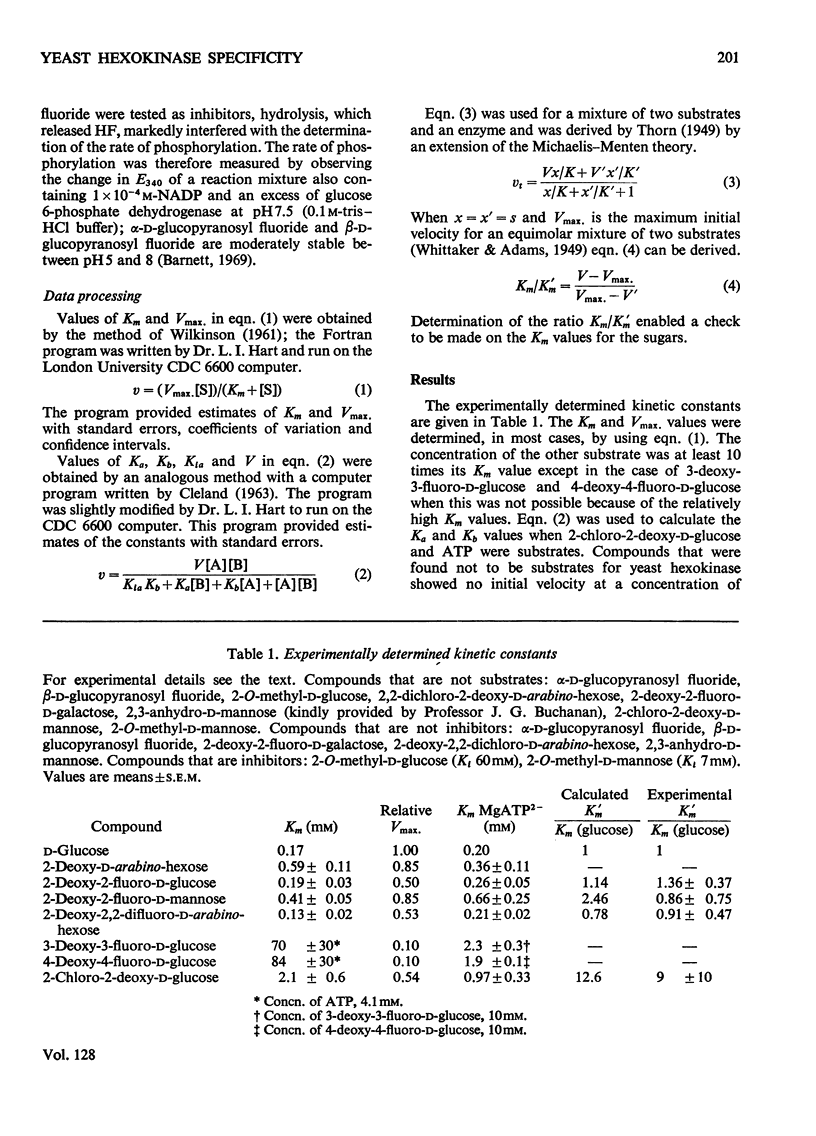
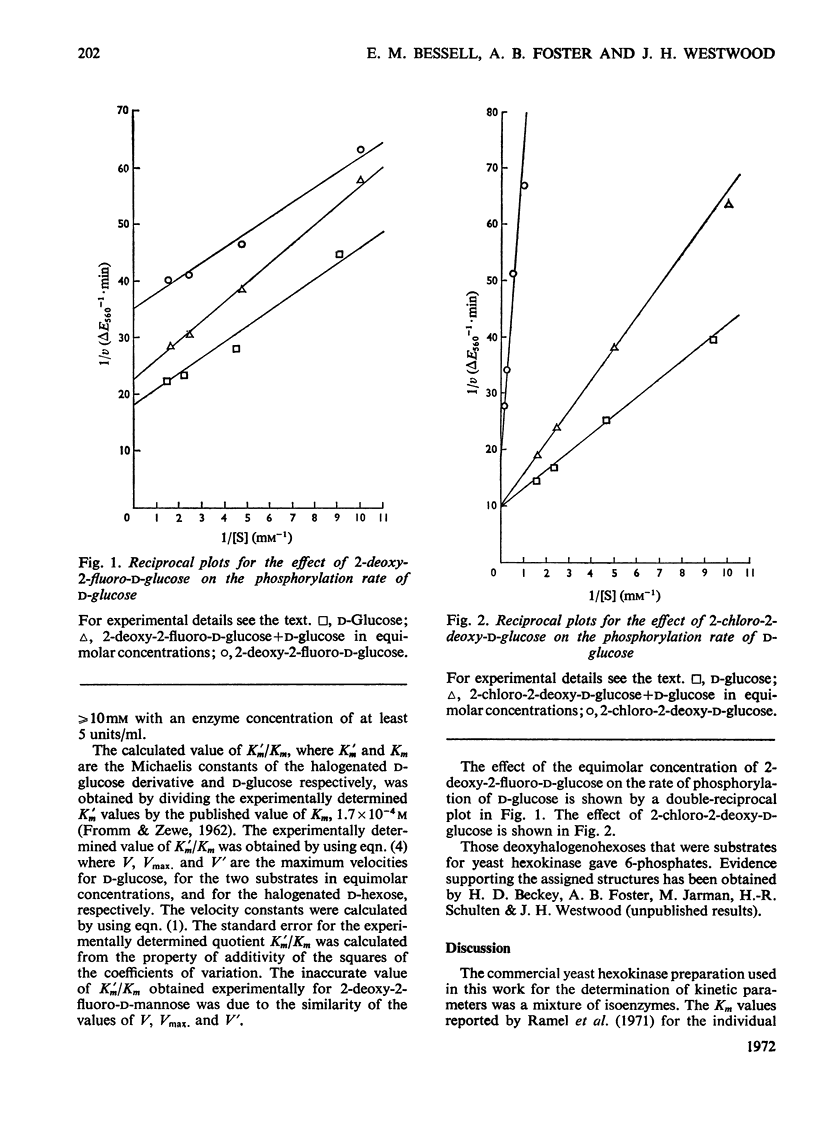
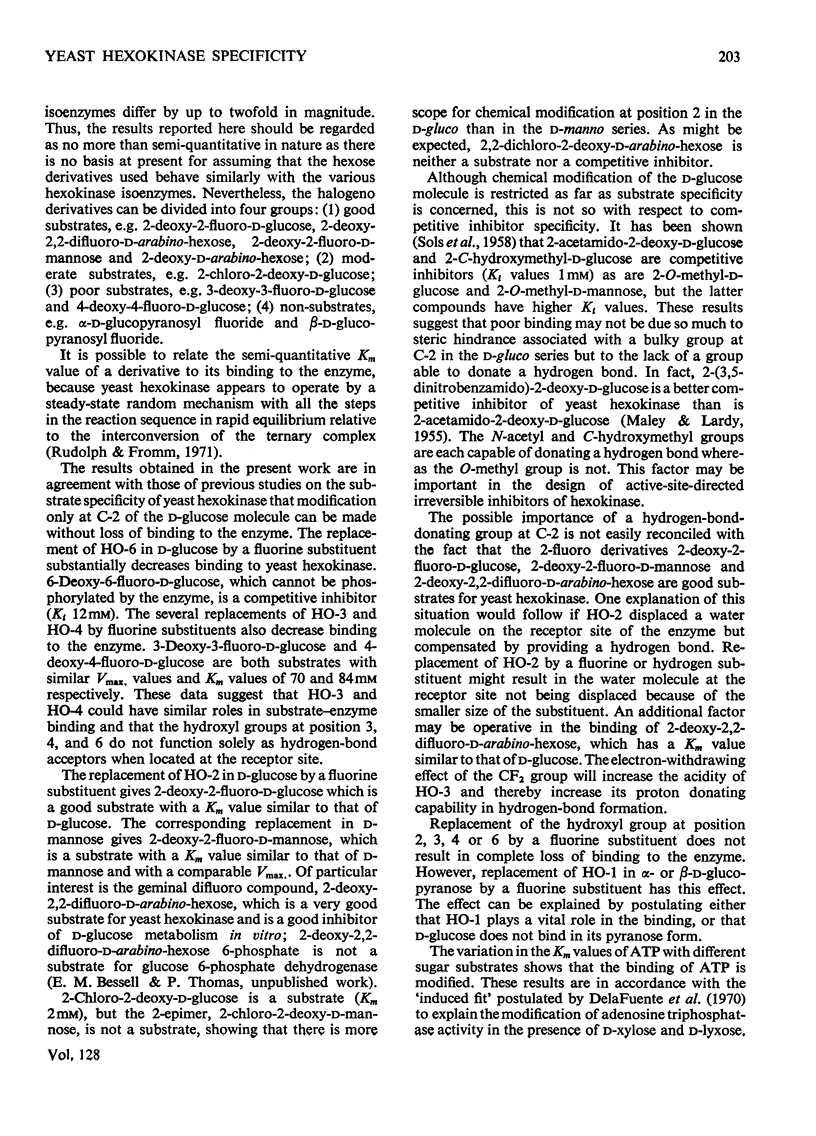
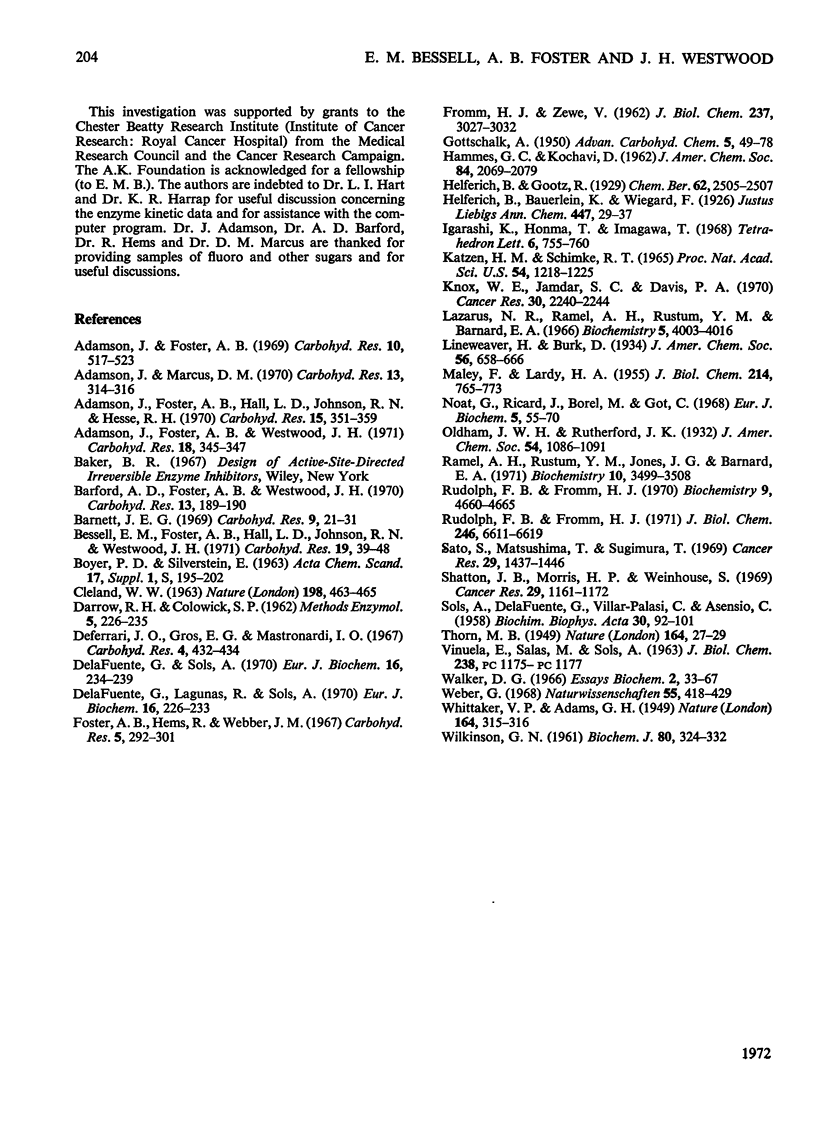
Selected References
These references are in PubMed. This may not be the complete list of references from this article.
- Adamson J., Foster A. B., Westwood J. H. 2-Deoxy-2,2-difluoro-D-arabino-hexose ("2,2-difluoroglucose"). Carbohydr Res. 1971 Jun;18(2):345–347. doi: 10.1016/s0008-6215(00)80363-8. [DOI] [PubMed] [Google Scholar]
- Bessell E. M., Foster A. B., Westwood J. H. Fluorinated carbohydrates. XI. 6-Deoxy-6-fluoro-D-glucose: an improved synthesis and the glycosyl fluoride derivatives. Carbohydr Res. 1971 Aug;19(1):39–48. doi: 10.1016/s0008-6215(00)80310-9. [DOI] [PubMed] [Google Scholar]
- CLELAND W. W. Computer programmes for processing enzyme kinetic data. Nature. 1963 May 4;198:463–465. doi: 10.1038/198463a0. [DOI] [PubMed] [Google Scholar]
- DelaFuente G., Lagunas R., Sols A. Induced fit in yeast hexokinase. Eur J Biochem. 1970 Oct;16(2):226–233. doi: 10.1111/j.1432-1033.1970.tb01075.x. [DOI] [PubMed] [Google Scholar]
- DelaFuente G., Sols A. The kinetics of yeast hexokinase in the light of the induced fit involved in the binding of its sugar substrate. Eur J Biochem. 1970 Oct;16(2):234–239. doi: 10.1111/j.1432-1033.1970.tb01076.x. [DOI] [PubMed] [Google Scholar]
- FROMM H. J., ZEWE V. Kinetic studies of yeast hexokinase. J Biol Chem. 1962 Oct;237:3027–3032. [PubMed] [Google Scholar]
- GOTTSCHALK A. Principles underlying enzyme specificity in the domain of carbohydrates. Adv Carbohydr Chem. 1950;5:49–78. doi: 10.1016/s0096-5332(08)60334-3. [DOI] [PubMed] [Google Scholar]
- Katzen H. M., Schimke R. T. Multiple forms of hexokinase in the rat: tissue distribution, age dependency, and properties. Proc Natl Acad Sci U S A. 1965 Oct;54(4):1218–1225. doi: 10.1073/pnas.54.4.1218. [DOI] [PMC free article] [PubMed] [Google Scholar]
- Knox W. E., Jamdar S. C., Davis P. A. Hexokinase, differentiation and growth rates of transplanted rat tumors. Cancer Res. 1970 Aug;30(8):2240–2244. [PubMed] [Google Scholar]
- MALEY F., LARDY H. A. Synthesis of N-substituted glucosamines and their effect on hexokinase. J Biol Chem. 1955 Jun;214(2):765–773. [PubMed] [Google Scholar]
- Noat G., Ricard J., Borel M., Got C. Kinetic study of yeast hexokinase. 1. Steady-state kinetics. Eur J Biochem. 1968 Jun;5(1):55–70. doi: 10.1111/j.1432-1033.1968.tb00337.x. [DOI] [PubMed] [Google Scholar]
- Ramel A. H., Rustum Y. M., Jones J. G., Barnard E. A. Yeast Hexokinase. IV. Multiple forms of hexokinase in the yeast cell. Biochemistry. 1971 Sep 14;10(19):3499–3508. doi: 10.1021/bi00795a003. [DOI] [PubMed] [Google Scholar]
- Rudolph F. B., Fromm H. J. Computer simulation studies with yeast hexokinase and additional evidence for the random Bi Bi mechanism. J Biol Chem. 1971 Nov;246(21):6611–6619. [PubMed] [Google Scholar]
- Rudolph F. B., Fromm H. J. Use of isotope competition and alternative substrates for studying the kinetic mechanism of enzyme action. I. Experiments with hexokinase and alcohol dehydroeenase. Biochemistry. 1970 Nov 24;9(24):4660–4665. doi: 10.1021/bi00826a007. [DOI] [PubMed] [Google Scholar]
- SOLS A., DE LA FUENTE G., VILLARPALASI C., ASENSIO C. Substrate specificity and some other properties of baker's yeast hexokinase. Biochim Biophys Acta. 1958 Oct;30(1):92–101. doi: 10.1016/0006-3002(58)90245-2. [DOI] [PubMed] [Google Scholar]
- Sato S., Matsushima T., Sugimura T. Hexokinase isozyme patterns of experimental hepatomas of rats. Cancer Res. 1969 Jul;29(7):1437–1446. [PubMed] [Google Scholar]
- Shatton J. B., Morris H. P., Weinhouse S. Kinetic, electrophoretic, and chromatographic studies on glucose-ATP phosphotransferases in rat hepatomas. Cancer Res. 1969 Jun;29(6):1161–1172. [PubMed] [Google Scholar]
- VINUELA E., SALAS M., SOLS A. Glucokinase and hexokinase in liver in relation to glycogen synthesis. J Biol Chem. 1963 Mar;238:1175–1177. [PubMed] [Google Scholar]
- WILKINSON G. N. Statistical estimations in enzyme kinetics. Biochem J. 1961 Aug;80:324–332. doi: 10.1042/bj0800324. [DOI] [PMC free article] [PubMed] [Google Scholar]
- Weber G. Carbohydrate metabolism in cancer cells and the molecular correlation concept. Naturwissenschaften. 1968 Sep;55(9):418–429. doi: 10.1007/BF00602650. [DOI] [PubMed] [Google Scholar]


